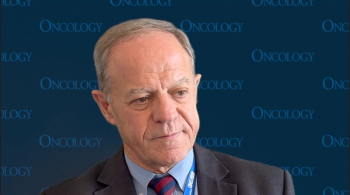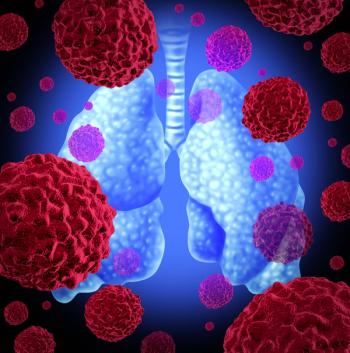
QOL, Pain Deterioration Improve With T-DXd in HER2-Low Breast Cancer
QOL data from DESTINY-Breast06 support T-DXd as a new therapeutic option in previously treated HER2-low and HER2-ultralow metastatic breast cancer.
Physical/role functioning deterioration and pain improved with trastuzumab deruxtecan (T-DXd; Enhertu) vs treatment of physician’s choice (TPC) among those with hormone receptor–positive (HR+), HER2-low or HER2-ultralow metastatic breast cancer (MBC), according to quality-of-life data (QOL) data from the DESTINY-Breast06 trial (NCT04494425) presented at the
Patient-reported outcomes (PROs) from the DESTINY-Breast06 trial (NCT04494425) showed a similar median time to deterioration (TTD) overall between the 2 arms in the intent-to-treat (ITT) population and the HER2-low subgroup, but differences in some symptoms. The median time to pain deterioration showed the most significant improvement for T-DXd at 22.0 months (95% CI, 17.2-not reached) vs 6.3 months (95% CI, 4.8-9.6) for TPC (HR, 0.51; 95% CI, 0.39-0.65).
“The global health/QOL was observed over 31 weeks for both arms. The QOL scores did not change from the baseline to a clinically significant degree,” Xichun Hu, MD, PhD, of the department of medical oncology in Fudan University Shanghai Cancer Center and professor in the department of oncology at Shanghai Medical College at Fudan University in Shanghai, China, said in his presentation. “Time to deterioration in QOL was similar with the 2 treatment arms. T-DXd reduced the risk of clinically meaningful deterioration in pain by 49%.”
The multicenter, open-label, randomized phase 3 DESTINY-Breast06 trial investigated the HR+, HER2-low population, defined as HER2 immunohistochemistry [IHC] 1+ or IHC 2+/in situ hybridization [ISH]-negative, as well as in patients with HR+, HER2-ultralow disease, defined as HER2 IHC 0 with membrane staining. The prior lines of therapy received by patients in this study included at least 2 lines of endocrine therapy with or without targeted therapy for MBC or those who had disease progression within 6 months of starting first-line endocrine therapy and CDK4/6 inhibitor therapy for MBC or recurrence within 24 months after starting adjuvant endocrine therapy.
Patients were randomly assigned on a 1:1 basis to receive 5.4 mg/kg T-DXd every 3 weeks or TPC chemotherapy including capecitabine, nab-paclitaxel, or paclitaxel.
In the primary analysis of the trial, investigators reported that it met its primary end point of progression-free survival per blinded independent central review (BICR) assessment with T-DXd showing 13.2 months compared with 8.1 months for TPC (HR, 0.62; 95% CI, 0.51-0.74; P < .0001).2
The patient-reported outcomes were assessed for both the ITT population (n = 436 for T-DXd and n = 430 for TPC) and the HER2-low group (n = 359 and n = 354, respectively).1 The median duration of treatment was 11.0 months with T-DXd vs 5.6 months with TPC chemotherapy. The European Organisation for Research and Treatment of Cancer QLQ-C30 oncology-specific questionnaire and the QLQ-BR45 breast cancer–specific questionnaire were assessed at baseline, every 3 weeks until the end of treatment, and then every 3 weeks until second progression or death.
The QLQ-C30 evaluated Global Health Status (GHS)/QOL, physical, emotional, role, social, and cognitive functional scales, and symptom scales. Hu reported that overall GHS/QOL were maintained over 31 weeks with T-DXd and TPC in the ITT population, with a mean baseline GHS score of 69.51 and 65.88, respectively. With a mean change of 10 points from baseline being considered meaningful, neither arm showed any significant shifts over time with 65.8% compliance in the T-DXd arm and 69.8% in the TPC arm. Median time to deterioration in GHS/QOL was 11.3 months (95% CI, 8.3-14.7) for T-DXd and 10.5 months (95% CI, 7.7-13.3) for TPC (HR, 0.93; 95% CI, 0.73-1.18).
In terms of pain, T-DXd significantly reduced the risk of deterioration per QLQ-C30. It also reduced risk of deterioration in several other outcomes including physical functioning (HR, 0.72; 95% CI, 0.56-0.92), role functioning (HR, 0.75; 95% CI, 0.60-0.94), emotional functioning (HR, 0.71; 95% CI, 0.53-0.95), and fatigue (HR, 0.76; 95% CI, 0.61-0.93). T-DXd was worse than TPC in nausea/vomiting (HR, 1.60; 95% CI, 1.28-2.02), appetite loss (HR, 1.33; 95% CI, 1.05-1.69), and constipation (HR, 1.74; 95% CI, 1.34-2.27).
The QLQ-BR45 evaluated multi-item scores including skin mycosis symptoms, body image, sexual functioning, arm symptoms, and breast symptoms. The TPC arm showed a clinically meaningful deterioration based on this measure, reaching a 10-point adjusted mean change from baseline at approximately 7 weeks and continuing to show 10 or more points difference through 31 weeks. However, the T-DXd arm did not differ significantly from baseline. “Among the components in the BR45 questionnaire, clinically meaningful deterioration of skin and mucosal system was observed with TPC, but not with T-DXd,” said Hu.
He emphasized that with a duration of treatment approximately double that of TPC, T-DXd maintained QOL as well as delaying time to deterioration in some areas. “Gastrointestinal [GI] symptoms reported by patients who receiving T-DXd highlight the importance to implementing antiemetic prophylaxis in the clinic. Further investigation of the effect of antiemetic prophylaxis on GI symptoms and associated QOL in patients receiving T-DXd is warranted,” said Hu.
He added that the GI adverse events reported in the QOL data “did not appear to be detrimental to overall preservation of QOL and were consistent with the safety profile reported by study investigators.”
“PRO results describing patients’ perspective further support T-DXd as a new therapeutic option following 1 or more endocrine-based therapies for patients with HER2-low and HER2-ultralow, HR+ MBC,” he concluded.
References
- Hu X, Curigliano G, Yonemori K, et al. Effects of trastuzumab deruxtecan (T-DXd) vs choice of chemotherapy (TPC) on patient-reported outcomes (PROs) in hormone receptor-positive, HER2-low or HER2-ultralow metastatic breast cancer (mBC): Results from DESTINY-Breast06. Presented at: 2024 ESMO Congress; September 13-17, 2024; Barcelona, Spain. Abstract LBA22.
- Curigliano G, Hu X, Dent RA, et al. Trastuzumab deruxtecan (T-DXd) vs physician’s choice of chemotherapy (TPC) in patients (pts) with hormone receptor-positive (HR+), human epidermal growth factor receptor 2 (HER2)-low or HER2-ultralow metastatic breast cancer (mBC) with prior endocrine therapy (ET): primary results from DESTINY-Breast06 (DB-06). J Clin Oncol. 2024;42(suppl 17):LBA1000. doi:10.1200/JCO.2024.42.17_suppl.LBA1000
Newsletter
Stay up to date on recent advances in the multidisciplinary approach to cancer.


















































































